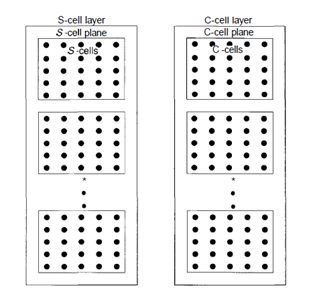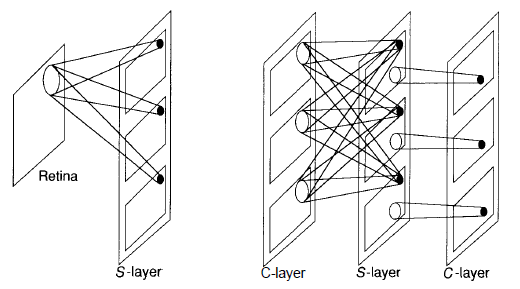The Neocognitron
Introduction:- The neocognitron design evolved from an earlier model called the cognitron,and there are several versions of the neocognitron itself. The system was designed to recognize the numerals 0 through 9, regardless of where they are placed in the field of view of the retina. Moreover, the network has a high degree of tolerance to distortion of the character and is fairly insensitive to the size of the character. This first architecture contains only feed forward connections.
 Functional Description:-The PEs of the neocognitron are organized into modules that we shall refer to as levels. Each level consists of two layers: a layer of simple cells, or S-cells, followed by a layer of complex cells, or C-cells. Each layer, in turn, is divided into a number of planes, each of which consists of a rectangular array of PEs. On a given level, the S-layer and the C-layer may or may not have the same number of planes. All planes on a given layer will have the same number of PEs; however, the number of PEs on the S-planes can be different from the number of PEs on the C-planes at the same level. Moreover, the number of PEs per plane can vary from level to level. There are also PEs called Vs-cells and Vc-cells. Here We construct a complete network by combining an input layer, which we shall call the retina, with a number of levels in a hierarchical fashion.
Functional Description:-The PEs of the neocognitron are organized into modules that we shall refer to as levels. Each level consists of two layers: a layer of simple cells, or S-cells, followed by a layer of complex cells, or C-cells. Each layer, in turn, is divided into a number of planes, each of which consists of a rectangular array of PEs. On a given level, the S-layer and the C-layer may or may not have the same number of planes. All planes on a given layer will have the same number of PEs; however, the number of PEs on the S-planes can be different from the number of PEs on the C-planes at the same level. Moreover, the number of PEs per plane can vary from level to level. There are also PEs called Vs-cells and Vc-cells. Here We construct a complete network by combining an input layer, which we shall call the retina, with a number of levels in a hierarchical fashion.
The interconnection strategy is unlike that of networks that are fully interconnectedbetween layers, such as the backpropagation network. Each layer of simple cells acts as a feature extraction system that uses the layer preceding it as its input layer. On the first S-layer, the cells on each plane are sensitive to simple features on the retina—in this case, line segments at different orientation angles. Each S-cell on a single plane is sensitive to the same feature, but at different locations on the input layer. S-cells on different planes respond to different features.

This diagram is a schematic representation of the interconnection strategy of the neocognitron. (a) On the first level, each S unit receives input connections from a small region of the retina. Units in corresponding positions on all planes receive input connections from the same region of the retina. The region from which an S-cell receives input connections defines the receptive field of the cell, (b) On intermediate levels, each unit on an s-plane receives input connections from corresponding locations on all C-planes in the previous level. C-celIs have connections from a region of S-cells on the S level preceding it. If the number of C-planes is the same as that of S-planes at that level, then each C-cell has connections from S-cells on a single s-plane. If there are fewer C-planes than S-planes, some C-cells may receive connections from more than one S-plane.
Each cell in a plane on the first S-layer receives inputs from a single input layer—namely, the retina. On subsequent layers, each S-cell plane receives inputs from each of the C-cell planes immediately preceding it. The situation is slightly different for the C-cell planes. Typically, each cell on a C-cell plane examines a small region of S-cells on a single S-cellplane
This discrepancy occurs because the system designers found it advantageous to combine the inputs from some S-planes to a single C-plane if the features that the S-planes were detecting were similar. This tuning process is evident in several areas of the network architecture and processing equations.